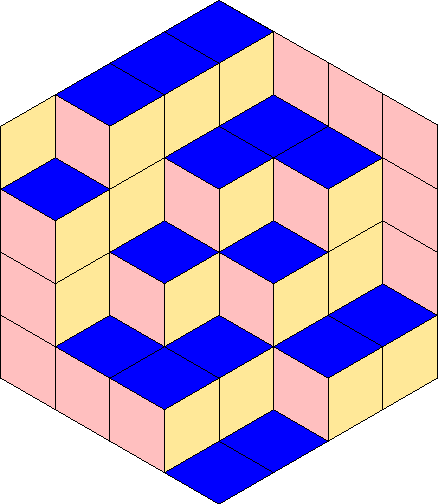In recent years, the generalization of the Erdős–Ko–Rado (EKR) theorem to permutation groups has been of much interest. A transitive group is said to satisfy the EKR-module property if the characteristic vector of every maximum intersecting set is a linear combination of the characteristic vectors of cosets of stabilizers of points. This generalization of the well-known permutation group version of the Erdős–Ko–Rado (EKR) theorem was introduced by K. Meagher in [28]. In this article, we present several infinite families of permutation groups satisfying the EKR-module property, which shows that permutation groups satisfying this property are quite diverse.
Revised:
Accepted:
Published online:
Keywords: Erdős–Ko–Rado theorems, permutation groups, EKR-module property, derangement graphs
Li, Cai-Heng 1; Pantangi, Venkata Raghu Tej 2
 CC-BY 4.0
CC-BY 4.0
@article{ALCO_2024__7_2_577_0,
author = {Li, Cai-Heng and Pantangi, Venkata Raghu Tej},
title = {On the {EKR-module} property},
journal = {Algebraic Combinatorics},
pages = {577--596},
publisher = {The Combinatorics Consortium},
volume = {7},
number = {2},
year = {2024},
doi = {10.5802/alco.339},
language = {en},
url = {https://alco.centre-mersenne.org/articles/10.5802/alco.339/}
}
TY - JOUR AU - Li, Cai-Heng AU - Pantangi, Venkata Raghu Tej TI - On the EKR-module property JO - Algebraic Combinatorics PY - 2024 SP - 577 EP - 596 VL - 7 IS - 2 PB - The Combinatorics Consortium UR - https://alco.centre-mersenne.org/articles/10.5802/alco.339/ DO - 10.5802/alco.339 LA - en ID - ALCO_2024__7_2_577_0 ER -
Li, Cai-Heng; Pantangi, Venkata Raghu Tej. On the EKR-module property. Algebraic Combinatorics, Volume 7 (2024) no. 2, pp. 577-596. doi : 10.5802/alco.339. https://alco.centre-mersenne.org/articles/10.5802/alco.339/
[1] A new proof for the Erdős–Ko–Rado theorem for the alternating group, Discrete Math., Volume 324 (2014), pp. 28-40 | DOI | MR | Zbl
[2] The Erdős–Ko–Rado property for some 2-transitive groups, Ann. Comb., Volume 19 (2015) no. 4, pp. 621-640 | DOI | MR
[3] The Erdős-Ko-Rado property for some permutation groups, Australas. J. Combin., Volume 61 (2015), pp. 23-41 | MR
[4] The EKR-module property of pseudo-Paley graphs of square order, Electron. J. Combin., Volume 29 (2022) no. 4, Paper no. 4.33, 19 pages | DOI | MR
[5] Spectra of Cayley graphs, J. Combin. Theory Ser. B, Volume 27 (1979) no. 2, pp. 180-189 | DOI | MR
[6] Maximal subgroups of low rank of finite symmetric and alternating groups, J. Fac. Sci. Univ. Tokyo Sect. IA Math., Volume 18 (1971/72), pp. 475-486 | MR | Zbl
[7] On the Erdős–Ko–Rado property for finite groups, J. Algebraic Combin., Volume 42 (2015) no. 1, pp. 111-128 | DOI | MR
[8] Cyclotomy and strongly regular graphs, J. Algebraic Combin., Volume 10 (1999) no. 1, pp. 25-28 | DOI | MR | Zbl
[9] Intersecting families of permutations, European J. Combin., Volume 24 (2003) no. 7, pp. 881-890 | DOI | MR
[10] of finite groups: Maximal subgroups and ordinary characters for simple groups, Oxford University Press, Eynsham, 1985, xxxiv+252 pages | MR
[11] An algebraic approach to the association schemes of coding theory, Philips Res. Rep. Suppl. (1973) no. 10, p. vi+97 | MR
[12] On imprimitive rank 3 permutation groups, J. Lond. Math. Soc. (2), Volume 84 (2011) no. 3, pp. 649-669 | DOI | MR
[13] Generating a random permutation with random transpositions, Z. Wahrsch. Verw. Gebiete, Volume 57 (1981) no. 2, pp. 159-179 | DOI | MR
[14] Setwise intersecting families of permutations, J. Combin. Theory Ser. A, Volume 119 (2012) no. 4, pp. 825-849 | DOI | MR | Zbl
[15] Intersection theorems for systems of finite sets, Quart. J. Math. Oxford Ser. (2), Volume 12 (1961), pp. 313-320 | DOI | MR
[16] On the maximum number of permutations with given maximal or minimal distance, J. Combin. Theory Ser. A, Volume 22 (1977) no. 3, pp. 352-360 http://www.sciencedirect.com/science/article/pii/0097316577900097 | DOI | MR | Zbl
[17] The Erdős–Ko–Rado theorem for vector spaces, J. Combin. Theory Ser. A, Volume 43 (1986) no. 2, pp. 228-236 | DOI | MR
[18] A new proof of the Erdős–Ko–Rado theorem for intersecting families of permutations, European J. Combin., Volume 30 (2009) no. 2, pp. 404-414 | DOI | MR
[19] Erdős–Ko–Rado Theorems: Algebraic Approaches, Cambridge Studies in Advanced Mathematics, 149, Cambridge University Press, Cambridge, 2016, xvi+335 pages | DOI | MR
[20] Algebraic graph theory, Graduate Texts in Mathematics, 207, Springer-Verlag, New York, 2001, xx+439 pages | DOI | MR
[21] On maximum intersecting sets in direct and wreath product of groups, European J. Combin., Volume 103 (2022), Paper no. 103523, 11 pages | DOI | MR
[22] Character theory of finite groups, AMS Chelsea Publishing, Providence, RI, 2006, xii+310 pages | DOI | MR
[23] The rank permutation representations of the finite classical groups, Trans. Amer. Math. Soc., Volume 271 (1982) no. 1, pp. 1-71 | DOI | MR
[24] Stable sets of maximal size in Kneser-type graphs, European J. Combin., Volume 25 (2004) no. 5, pp. 657-673 | DOI | MR
[25] Erdős–Ko–Rado problems for permutation groups, 2020 | arXiv
[26] The finite primitive permutation groups of rank three, Bull. London Math. Soc., Volume 18 (1986) no. 2, pp. 165-172 | DOI | MR
[27] Characterization of intersecting families of maximum size in , J. Combin. Theory Ser. A, Volume 157 (2018), pp. 461-499 | DOI | MR
[28] An Erdős–Ko–Rado theorem for the group , Des. Codes Cryptogr., Volume 87 (2019) no. 4, pp. 717-744 | DOI | MR | Zbl
[29] On triangles in derangement graphs, J. Combin. Theory Ser. A, Volume 180 (2021), Paper no. 105390, 26 pages | DOI | MR
[30] All 2-transitive groups have the EKR-module property, J. Combin. Theory Ser. A, Volume 177 (2021), Paper no. 105322, 21 pages | DOI | MR | Zbl
[31] An Erdős–Ko–Rado theorem for the derangement graph of acting on the projective line, J. Combin. Theory Ser. A, Volume 118 (2011) no. 2, pp. 532-544 | DOI | MR | Zbl
[32] An Erdős–Ko–Rado theorem for finite 2-transitive groups, European J. Combin., Volume 55 (2016), pp. 100-118 | DOI | MR
[33] Finite quasiprimitive graphs, Surveys in combinatorics, 1997 (London) (London Math. Soc. Lecture Note Ser.), Volume 241, Cambridge Univ. Press, Cambridge, 1997, pp. 65-85 | DOI | MR
Cited by Sources:


